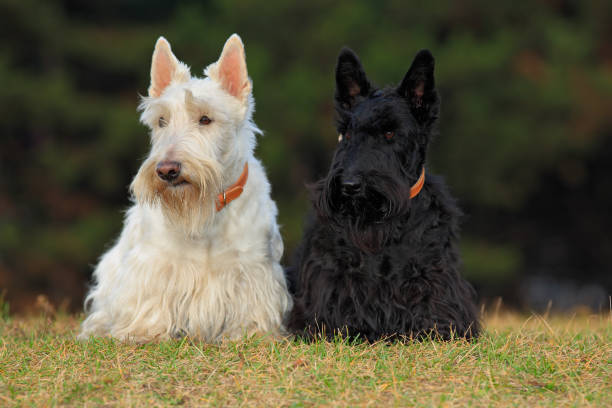Scottish Terrier

Breed History:
The Scottish Terrier, also known as the Scottie, is one of Scotland’s oldest and most iconic terrier breeds. It was originally developed in the Scottish Highlands for hunting vermin, badgers, and foxes. The breed’s roots go back to at least the 17th century, but the modern Scottish Terrier was refined in the 19th century.
It gained popularity in the UK and the U.S. during the early 20th century and was notably owned by President Franklin D. Roosevelt (his dog “Fala” became famous). Known for its dignified demeanour and distinctive silhouette, the Scottie is now a beloved companion breed.
|
Gender |
Height |
Weight |
|
Male |
25-28 cm |
8-10 kg |
|
Female |
23-25 cm |
8-9 kg |
Size – Small
Life Expectancy: 12–15 years

Breed Appearance:
The Scottish Terrier has a distinctive, sturdy build with short legs, a compact body, and a proud, upright stance. It has a long head, bushy eyebrows, a pronounced beard, and pointed, erect ears.
Its harsh, wiry double coat comes in black (most common), wheaten, or brindle. The Scottie has a prominent undercarriage and a tail that is medium-length and carried upright.
Breed Type – Companion/Vermin Hunter:
Bred as a working terrier, the Scottie is confident, alert, and dignified. It is loyal and devoted to its family but tends to be aloof or reserved with strangers.
Scotties are known for their independent, “no-nonsense” personality. While loving and affectionate with those they trust, they often prefer to do things on their own terms. They are generally good with older children and can live with other dogs, but may not tolerate small pets.

Training:
Scottish Terriers are intelligent but can be stubborn and independent, which may pose a challenge for first-time dog owners. Training requires patience, consistency, and a respectful, firm hand.
Positive reinforcement is the most effective method. Early socialisation helps reduce wariness of strangers and ensures they grow into well-rounded companions.
Health & Care:
Generally healthy, the Scottish Terrier may be prone to:
-
Scottie Cramp (a hereditary muscle disorder)
-
Von Willebrand’s disease (a bleeding disorder)
-
Bladder cancer (especially transitional cell carcinoma)
-
Allergies and skin conditions
Regular vet care and responsible breeding practices help minimise genetic issues. A balanced diet and moderate exercise also contribute to long-term health.

Living Conditions:
The Scottie adapts well to various living environments, including apartments, provided it receives regular walks and stimulation. It prefers a calm household and may not tolerate rough handling.
Due to its digging instinct and strong prey drive, a securely fenced yard is important for off-leash activity. Scotties are best suited for homes where they are not left alone for long periods.
Exercise:
While not hyperactive, Scotties are energetic and benefit from 30–60 minutes of daily exercise. This can include brisk walks, backyard play, and mental stimulation through games or training.
They enjoy digging and chasing, so supervised outdoor time is ideal. Mental enrichment is equally important to keep their sharp minds engaged.
Grooming:
-
Weekly brushing is needed to prevent matting
-
Hand-stripping or clipping is recommended every 6–8 weeks to maintain coat texture
-
Regular trimming around the eyes, paws, and ears
-
Routine nail trimming, dental care, and ear cleaning
While not heavy shedders, grooming is more involved than for smooth-coated breeds.

Advantages:
-
Loyal, affectionate, and protective of family
-
Compact size suitable for small homes
-
Alert watchdog—naturally suspicious of strangers
-
Independent and confident personality
-
Minimal shedding if regularly groomed
-
Long-lived with good care
Disadvantages:
-
Strong-willed and sometimes difficult to train
-
Can be aloof, especially with strangers or other pets
-
Needs consistent grooming and coat maintenance
-
May dig or chase small animals due to prey drive
-
Doesn’t always tolerate rough play or young children
-
Prone to breed-specific health issues

